December, 2005, vol. 2, no. 6
Image Stuff
Home
Editorial and Technical Staff:
Marlene Gordon (University of Michigan-Dearborn)
Dana Felder (Cooper Union)
Steve Kowalik (Hunter College)
Trudy Levy (Image Integration)
Contributions to Image Stuff are due the 20th of the month before the issue. Please send your copy in ".doc" format
Table
of Contents
VRA Elections
Upcoming Conferences
Documentary Films
VRA Funnies
Chartres Cathedral
VRA Special Bulletin #14
Tech Tip
Chapter News
![]()
I am very pleased to announce the names of the newly elected VRA Executive Board Officers. Please join me in welcoming our new Vice President for Conference Arrangements, Rebecca Moss (Director, Visual Resources Collection, University of Minnesota); Treasurer, Ann Woodward (Visual Resources Curator, Johns Hopkins University); and Public Relations and Communications Officer, Lise Hawkos (Visual Resources Curator, Arizona State University). These new officers will begin their terms at the Annual Conference in Baltimore, Maryland, March 2006.
On behalf of the Executive Board and the VRA membership, I would like to thank the entire slate of candidates. All of the nominees are committed and active members of VRA. These candidates serve the organization in many diverse capacities and we look forward to their continued commitment to VRA. Other nominees included David Seiler and Vickie O'Riordan.
Finally, I would like to thank Carolyn Lucarelli and the members of the Nominating Committee, who developed this strong slate of candidates, and Ann Burns, who served as teller for the election.
Kathe Albrecht
VRA President
Rebecca Moss
Vice President for Conference Arrangements
Director of Visual Resources Center, College of Liberal Arts, Office of Information Technology
University of Minnesota
Biographical Note:
Rebecca Moss is the Director of Visual Resources and the CLA-OIT Digital Content Lab at the University of Minnesota. From 1996 to 1999 she was the Slide Collection Cataloguer and Imaging Coordinator at the Fine Arts Slide Library at Indiana University, Bloomington, where she worked for and was mentored by Eileen Fry and B.J. Irvine. Rebecca received her BFA in Art History from the Herron School of Art (part of Indiana University Purdue University at Indianapolis) in 1995 and her MLS from Indiana University in 1997.
Rebecca has been active in the VRA at both the local and national level since 1999. She is past Secretary/Treasurer for the VRA Midwest Chapter, past Chair and Co-Chair of the Development Committee. She is a member of the IPR Committee webpage and has served as the organizer for the New Technology Roundup, the VRA Raffle and is now one of the VRAffle Rousers. She presented a poster session at the Educause conference in 2002 and has served on the organizing committee for the MINERVA symposium for the past four years.
Statement of Personal Goals as Vice President for Conference Arrangements:
As a VR professional, I look forward to the conferences for many reasons. I get to travel to places I might not otherwise. I get to stay in quality hotels, go on local tours and see how my colleagues in other cities do their job. Hearing from others about their successes and failures and seeing the changing priorities among my peers makes me come home energized and ready to try some new things. I love seeing friends from past years, and I always end up making new ones. A good conference should have all these elements and more. One of the many people making all this happen is the VP for Conference Arrangements.
Before I found my calling working with image libraries and computer technology, I spent 17 years working in the hospitality industry. Many years of waitressing, bartending, and catering to the public have given me some invaluable skills (including the ability to deal with troublesome patrons who are not unlike faculty at times). I spent almost six years working at a large hotel in Key West, doing a variety of jobs from concierge to hotel operator to bellman. These experiences help me to understand many of the inner workings of conference arrangements. In addition, what I've learned from watching the other excellent VP's we have had helps make me uniquely qualified for this position. It would be an honor to help ensure our conferences remain informative, entertaining, memorable, and hopefully, well run.
Ann Woodward
Candidate for Treasurer
Curator, Visual Resources Collection, History of Art Department
Johns Hopkins University
Biographical Note:
Ann D. Woodward has worked in the Visual Resources Collection at Johns Hopkins University since 1995. She became the curator of the collection in 1998. From 1975-78 she was the Curator of the Slide and Music Collection at the University of Michigan - Dearborn, and from 1978-82, the Administrative Assistant in the Center for Chinese Studies at the University of Michigan. Ms. Woodward received a BA in Art History from Connecticut College in 1971 and an MA in Art History (with a concentration in Asian art) from the University of Michigan in 1978. She attended Nancy DeLaurier's course for slide curators at the University of Missouri - Kansas City.
Ms. Woodward has served as both treasurer and chairman of the Women's Committee of the Walters Art Museum and was an ex-officio member of the Board of Trustees of the Walters from 1995-97, also serving on the Education Committee of the Board. She has co-chaired the annual fundraiser "Art Blooms at the Walters" twice, and has also served as the treasurer for this event. For the past five years she has been the treasurer for a women's investment club (structured as a mutual fund); she did the accounting to change it from an equal-shares ownership fund to a mutual fund.
Ms. Woodward has been a member of the VRA for a number of years. Currently she is the chair of the Mid-Atlantic chapter, and a member of the VRA's Education Committee.
Statement of Personal Goals as Treasurer:
One of the most extraordinary things about the visual resources profession is the Visual Resources Association; it is both a resource and a community. As one of the many beneficiaries of the publications, training and advice which are so generously shared in this community, I felt that it was time for me to return some volunteer effort to the VRA.
I have served as the treasurer for a number of organizations and have both paid and volunteer bookkeeping experience. As treasurer my goal would be to handle transactions in a timely and professional manner and to produce reports that reflect the financial state of the VRA and are of use to the board and the membership.
Lise Hawkos
Candidate for Public Relations and Communications Officer
Curator, Visual Resources Collection, School of Art
Arizona State University
Biographical Note:
Lise Hawkos has been the Visual Resources Curator for the School of Art at Arizona State University in Tempe, Arizona since 1981. She has a Bachelor of Arts degree in painting and a Master's Degree in Art History from the University of Wisconsin, Madison. Since 1992 in addition to her VR duties, Lise has been responsible for directing the School of Art student galleries and teaching the gallery exhibition class.
Ms. Hawkos has been active in the Visual Resources Association from the early days, presenting papers on database management, disaster preparation and copyright issues. She has been on the Nomination and Intellectual Properties committees, published a Special Bulletin on disaster planning and in the VRA Bulletin, and served two terms as Vice-President in charge of conference program and planning. She has also been active in ARLIS/NA especially at the local and regional level.
Statement of Personal Goals as Public Relations and Communication Officer:
It is rather sobering to realize that I have been involved with visual resources generally and the VRA specifically for over half of my life. There have been so many changes and developments along the way that it sometimes feels like a completely different field. I am fortunate to have gotten my start working under Chris Sundt and when I got my own collection, Chris was there to make sure that I continued along the right path and introduced me to the community of the VRA. In the ensuing years I have learned much from the VRA and have had the opportunity to work with and learn from many incredible individuals. I have seen the VRA change from an organization where all the conference attendees could fit into one session room, and eat together in the same restaurant, where the publications were typed and Xeroxed, and if you had a question, you'd pick up the phone (actually, I hope we are still doing that), to an organization of an ever increasing number of professionals, with a growing sophistication in style and technology.
The VRA has had and maintains a reputation for the quality of its work, especially the VRA Bulletin and Special Bulletins, and the VRA-L and website are outstanding resources for the field. I am interested in being elected to the office of Public Relations and Communication Officer because I would like to have a role in seeing not only that this precedent be continued, but to further develop our organizational identity. I bring experience in print design and desk-top publishing, and I have also been responsible for all print materials for four annual meetings. In my role as gallery administrator for the School of Art I am responsible for print and web publications and PR. As can be said of most of us, my positions require that I work collaboratively with a varied group of people. I enjoy this part of my job, and am considered good at it. The opportunity to coordinate the Publications Program group and to once again work with the VRA board appeals to me as well.
![]()
Visual Resources Association
Image is Everything!
March 6-11, 2006
The 24th Annual Conference will be held in Baltimore at the Hyatt Regency on the Inner Harbor.
Information on the sessions, seminars, and workshops is available on the VRA web site. Many popular events are also scheduled including the Member's Reception, the famous VRAffle and the Tansey Dinner.
College Art Association
94th Annual Conference
February 22-25, 2006
Going Digital: Tools and Resources for Teaching
Thursday, February 23, 2006, 12:3 pm - 2:00 pm
Sponsored by the Visual Resources Association
Chair: Jeanne Keefe, Rensselaer Polytechnic Institute
Freeware and Shareware Solutions for Managing Personal Image Collections
Virginia Hall, Johns Hopkins University
Introducing DIRC (Digital Image Rights Computator): An Interactive Tool for Assessing Intellectual Property Rights in Images
Allan Kohl, Minneapolis College of Art and Design
This One is a Keeper: One Stop Shopping for Quality Content
Carmen Wiedenhoeft, Saskia Ltd/Scholars Resource Inc.
![]()
Fair Use Statement for Documentary Filmmakers Released
By Jane Darcovich, (University of Illinois at Chicago) - VRA Intellectual Property Rights Committee
New research on the problems that documentary filmmakers face with the copyright clearance process has resulted in the publication of a statement on Fair Use for that profession. The statement is one product of a collaborative research project of American University's Center for Social Media and the Washington College of Law Program on Intellectual Property and the Public Interest (PIPPI), headed by co-principal investigators Patricia Aufderheide and Peter Jaszi. Titled "Documentary Filmmakers Statement of Best Practices in Fair Use", the document was officially released on November 18, 2005. The project received support from the Rockefeller Foundation and the John D. and Catherine T. MacArthur Foundation.
The Statement of Best Practices in Fair Use describes documentary filmmakers' understanding about what is reasonable in employing fair use. Filmmakers and their national organizations, including the Association of Independent Video and Filmmakers, Independent Feature Project, International Documentary Association, National Alliance for Media Arts and Culture, and Women in Film and Video (Washington D.C. chapter) worked with the project group at American University to craft the document, which outlines four broad types of situations in which documentary filmmakers agree they have the right to quote copyrighted material without licensing it.
A November 2004 report produced by the project, titled "Untold Stories: Creative Consequences of Rights Clearance Culture for Documentary Filmmakers" summarizes the results of primary research obtained through interviews with 45 directors, editors and producers of documentary films. Among the findings are that filmmakers must often eliminate authentic details such as music, and background television broadcasts from their documentary films because of the high costs and difficulties surrounding the rights clearance process. These interviews revealed that use of film clips from a variety of commercial and archival sources also comes at a high price, when permission is granted. The results of these copyright clearance difficulties are a loss of public access to the images used to recall history as well as the sound (music) of history.i
The interview project also revealed lack of understanding among documentary filmmakers about situations in which copyright clearance is needed, and those in which fair use is appropriate. Much like the difficulties experienced by those in the academic, library and museum communities trying to creatively re-use orphan works, documentary filmmakers are often very cautious, fearful of the gray area of fair use. ii
The creation of a model of best practices for fair use was one of the main recommendations emerging from the interview project with documentary filmmakers. The Documentary Filmmakers' Statement of Best Practices in Fair Use is intended to help filmmakers, broadcasters and insurers employ the doctrine of fair use with greater assurance than they have had in the past. The aims of the Statement are as follows iii:
- to clarify the limits on copyright and trademark law
- to encourage filmmakers to rely upon fair use where appropriate
- to persuade gatekeepers to accept well-founded assertions of fair use, and to discourage copyright owners from threatening or bringing lawsuits relating to documentary projects
- in the event of a lawsuit, to provide the defendant with a basis on which to demonstrate that his or her uses were reasonable and undertaken in good faith
The Statement of Best Practices is seen as one component of a strategy to assist filmmakers in becoming more aware of accepted practices in fair use today. It may also assist rights holders by clarifying reasonable expectations for fair use for documentary productions.
The web page for the project contains a wealth of related information, including examples of successful applications of fair use in documentary films, a summary guide to determining which copyrighted works are now in the public domain, and a link to a short video which describes some of the problems documentary filmmakers faced in negotiating the rights clearance process.
- http://www.centerforsocialmedia.org/rock/backgrounddocs/faqnov05.pdf p. 20
- http://www.centerforsocialmedia.org/rock/backgrounddocs/printable_rightsreport.pdf, pp. 24-25
- http://www.centerforsocialmedia.org/rock/backgrounddocs/faqnov05.pdf, p. 2
![]()
VRA Funnies
By Jonathan Cartledge (Massachusetts College of Art)
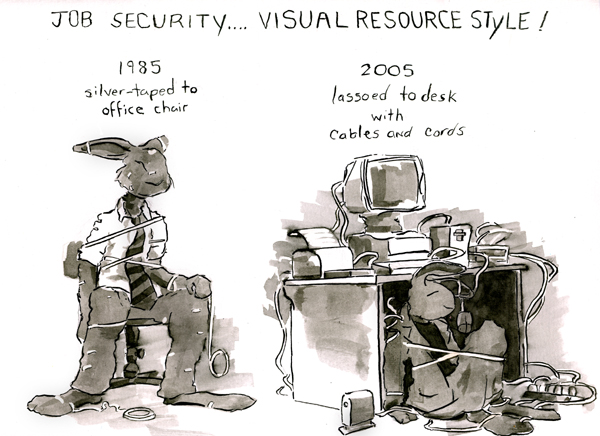
![]()
Strategies for Transitioning to the Age of Digital Media
by Sarah E. Cheverton and Christina B. Updike
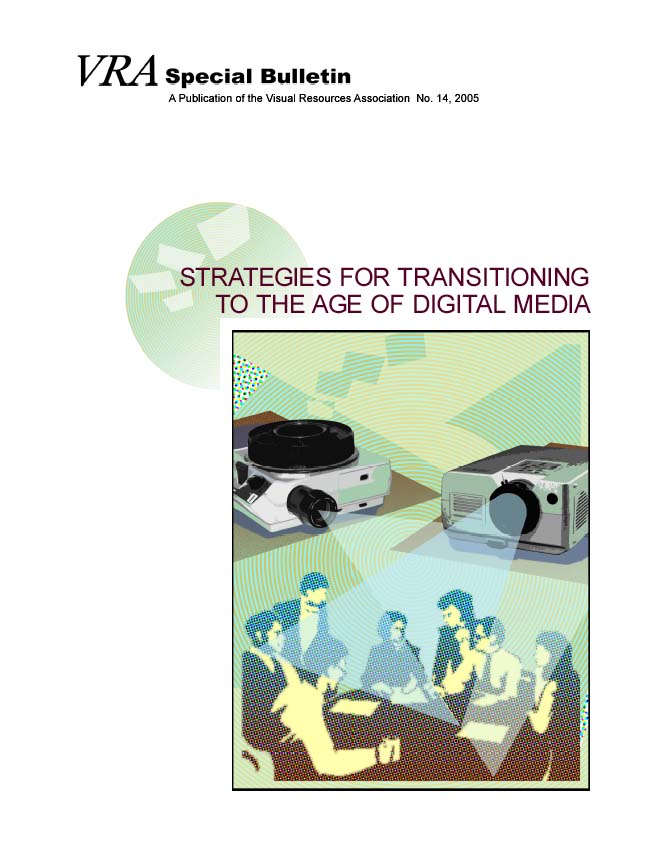
If you are among those searching for answers from experienced colleagues who have successfully managed the transition to digital technology, then you will be pleased to learn that the next publication in the VRA Special Bulletin series of occasional papers addresses this need. This "must-have" volume is essential for any visual resources collection contemplating or on the verge of converting from analog to digital. Drawing upon their experience at James Madison University, authors Sarah Cheverton and Tina Updike relate their lessons learned as well as keys to continued success.
This Special Bulletin identifies strategic actions that will facilitate the change from analog to digital media for all key players. It is the result of a workshop developed by Cheverton and Updike for presentation at the VRA Annual Meeting 2004 and subsequently presented at the VRA Summer Educational Institute. The emphasis is on identifying positive actions, encouraging collaboration, and helping faculty cope with the transition to digital media.
It includes digital media surveys for professionals and instructional faculty, summaries and action plan worksheets. A CD containing blank surveys and worksheets for use by the home institution is included with the Special Bulletin.
85 pages, 4 tables, illus., print bibliography and Internet resources, companion CD. Spiral-bound. $35.00.
For ordering information, please visit the publications page on the VRA website and submit your order online. PREPAYMENT IS REQUIRED. All payments must be made to the Visual Resources Association in U.S. currency only. Please do not initiate an order with a paper form only, even if you wish to pay by check or money order. If you wish, the online order form can be printed and sent with your payment to: Ann M. Thomas, VRA Treasurer, Department of Visual Arts, Union College, Arts Building, Room 214, Schenectady, NY 12308.
![]()
Chartres Cathedral
The University of Pittsburgh Database
By Edward A. Galloway, Coordinator, Digital Research Library, University Library System
University of Pittsburgh Unveils Web Site that includes more than 3,000 Images of Chartres Cathedral. Online collection offers a comprehensive view of the European monument
Detailed images of soaring aisles, delicate carvings, and stained-glass windows from the 12th and 13th centuries are captured on a new University of Pittsburgh Web site, http://images.library.pitt.edu/c/chartres, documenting the famous French Cathedral of Chartres (11th-16th centuries), located approximately 50 miles southwest of Paris.
A joint project of the University's Digital Research Library (DRL) and Pitt Professor of Art History Alison Stones, the new Web site provides access to more than 3,000 high-resolution images of Chartres Cathedral, each accompanied by descriptive information. Users can zoom in to examine intricate details of the cathedral's High Gothic style of architecture, the sculpture of its three major portals, the stained-glass windows depicting stories of the Old and New Testaments and the Lives of the Saints, the fragmentary wall paintings, and the
illuminations from two historic manuscripts used at the cathedral. (The library at Chartres was bombed by friendly fire in World War II, reducing most of its holdings to charred remains.)
Although the image collection was originally designed and partially funded by a University grant from the Office of the Provost to directly support Stones' teaching in her medieval art and architectural classes, the Web site is available to anyone interested in studying this
magnificent monument. Moreover, Stones hopes that the Web site will greatly impact her field of study. There is no substitute for on-site study, but good, comprehensive Web coverage is essential for preparation and for follow-up. Books simply never include enough images for monuments to be fully comprehensible, she said.
The thousands of images amassed by Stones primarily represent photographs she and her collaborators took of the cathedral during many visits to France, most recently during a summer course taught on-site in May 2005. The images offer a compelling and comprehensive look at the rich architectural style of the cathedral and its fascinating history.
Medieval pilgrims journeyed to the cathedral to view a precious relic known as the Veil of the Virgin, a strip of cloth believed to have been worn by the Virgin Mary at the Nativity of Christ. Traditionally thought to have been a gift from the French King Charles the Bald (823-877), the veil has been housed since the 10th century at a Chartres cathedral.
The present cathedral primarily dates from the 11th to 16th centuries, with the major building campaigns occurring in the 12th and 13th centuries.
The cathedral has been restored several times; the most recent cleaning is under way today, so parts of the clerestory glass and some of the sculptures were unavailable to be photographed for the project.
Though there are several dozen Web sites on Chartres, Pitt's site is especially comprehensive. The zoom feature reveals tiny details of the figures and motifs in the windows and sculptures and on elements of tracery, moldings, and masonry in the architecture. Keyword searches can be performed over the descriptions that accompany each image.
We have equipped Dr. Stones with an unprecedented collection of images to support her teaching and instruction, said Ed Galloway, DRL coordinator, adding that it represents the largest image collection DRL has hosted. Further, students at Pitt and elsewhere now have convenient access to a critical mass of images to further their understanding and research on Chartres.
The Rector of Chartres Cathedral and the librarians of the Bibliotheque Municipale de Chartres and the Bibliothque Municipale d'Orlans gave permission for the project team to photograph and mount these images.
![]()
Tech Tips
By Alexander Nichols (Michigan State University)
What digital camera settings are recommended for copy stand photography?
Manual is the ideal exposure mode. The ideal aperture is usually between f/5.6 and f/11 -- do some tests to determine which aperture setting is sharpest for your lens (pay particular attention to the corners of the image). Choose whatever shutter speed matches with your ideal aperture to make a good exposure (don't rely on the camera's light meter). The file format should be set to RAW. Create a custom white balance setting using a gray or white card. In-camera sharpening should be set to its lowest setting (or "Off," if available). ISO rating equivalent should be at the lowest available setting (usually 50, 100, or 200).
How do I determine proper exposure with a digital camera?
Many digital cameras (including all digital SLRs) have a display feature called a histogram. The histogram is a graph of exposure information (in the form of peaks and valleys) for a given image. Peaks on the right-hand side of the graph represent bright areas (highlights) in the image, peaks in the middle represent mid-tones, and peaks on the left represent dark areas (shadows). In a well-exposed image, the histogram will show valleys at the extreme left and the extreme right. If the far right side of the graph ends in a peak, the image is over-exposed and highlight detail is being lost, while if the far left side of the graph ends in a peak, the image is under-exposed and shadow detail is being lost.
Copy stand photography will typically yield images with low dynamic range that do not fill the histogram from right to left, regardless of exposure settings. In this case, set exposure such that the graph is pushed as far to the right as possible, making sure that the scale still ends in a valley. This may result in "flat" looking images out-of-camera, but that can be quickly corrected with Levels in Photoshop. "Exposing to the right" has the benefit of capturing more subtle gradations of tone than exposing to the left or middle of the histogram

VRA New England and Upstate New York joint meeting at Middlebury College. Photos are courtesy of Megan Battey
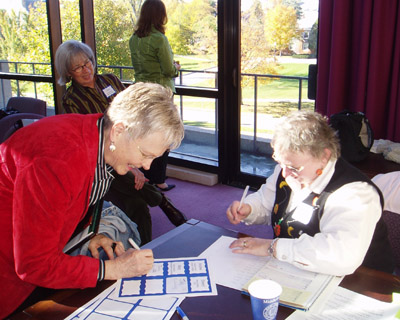
VRA NE Treasurer Melody Ennis (RISD Museum) checks in Judy Watts (Middlebury College); VRA Secretary and member of both chapters Linda Reynolds (Williams College) looks on as Marcie Hahn (Roger Williams University) enjoys the beautiful view of Middlebury and the mountains from the Johnson Arts Building.
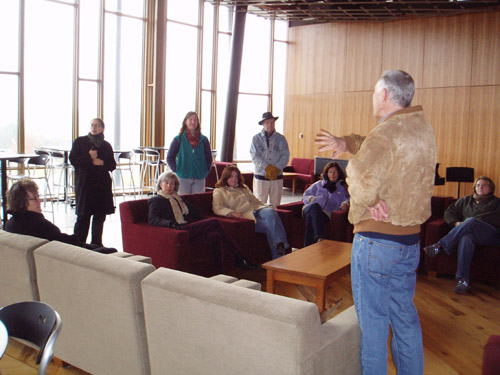
On Saturday, October 22, Middlebury College architectural historian Glenn Andres (right) led a special campus tour. We warmed our hands in the new Atwater Cafeteria on seating custom made by Vermont furniture makers.
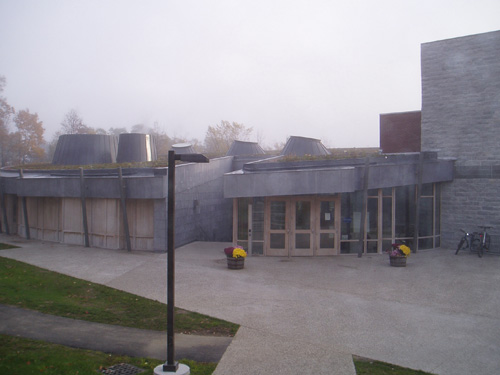
The Cafeteria's "green roof" is just one of the elements that makes this building a model for environmentally friendly design.
